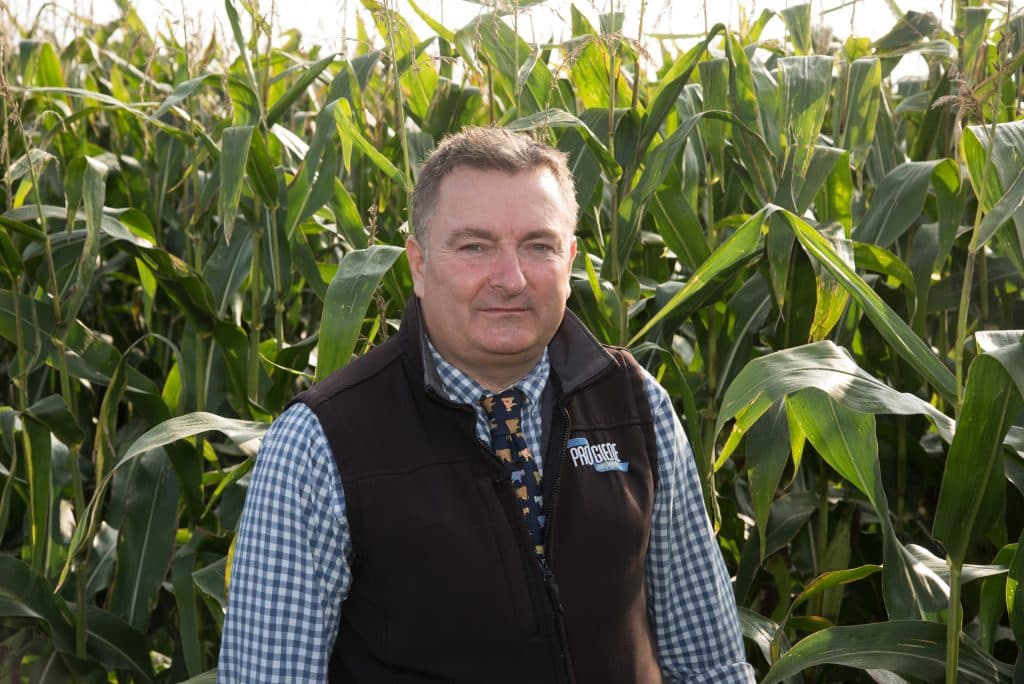Maize: Off to a flying start – CPM – Jim Clark, Tim Kerr, Peter Brundle
As one maize season draws to a close CPM looks ahead to the spring ...
To find out how growers can prepare nutritional programmes to optimise crop establishment and growth.
By Paul Spackman
Strong establishment plays a central part in any crop when it comes to fulfilling its yield potential. But in seasons like the one just gone, achieving a good plant stand can be a real challenge. This is particularly true for short-season, spring-sown crops like maize, says Cumbria-based Hutchinsons agronomist Jim Clark.
“To make the most of the short growing season, strong foundations must be established quickly to maximise yield-building capacity and bolster crop resilience against weather extremes and other pressures.

Jim Clark, agronomist
“The exceptionally dry spring of 2020 on the back of a wet winter reinforces the importance of managing soils carefully over autumn and winter to improve the chances of creating a good seedbed and achieving strong establishment the following spring,” he highlights.
This is especially true in areas where soils could have been damaged this autumn by a late harvest of the preceding crop.
“Maize really doesn’t like compaction, so if the field’s not in good condition and structural issues cannot be rectified properly, you have to question whether it should be grown there,” suggests Jim.
Soil management
“Pick your sites carefully and be realistic about where to grow maize. Soil management is quite challenging. Especially in wetter areas further north and west, which are already on the extremes of the maize-growing area.”
Detailed soil analysis – such as that provided by TerraMap – offers a valuable way of evaluating soil health, identifying structural issues, and accurately determining soil nutrient status well before drilling, he notes. Well targeted nutrition drives successful maize establishment and is something Jim is focussing on at the firm’s Carlisle Regional Technology Centre.
This year’s trials are examining whether phosphate starter fertilisers can overcome potential limitations during establishment to deliver a worthwhile benefit in maize grown under film. The approach is already more commonly used in open-ground crops where diammonium phosphate (DAP) is often applied with seed, but it was traditionally thought unnecessary for maize grown under film as the warmer soil increases the availability of soil nutrients such as phosphate. Other financial and technical limitations may have also prevented it from becoming common practice, says Jim, although he believes the Hutchinsons’ trials could change this view.
The Carlisle site features several large plots (six rows wide, by 50-100m long) of P7034 maize, sown on 18 April under Samco green film. A specially modified drill was developed to carry a micro-granule applicator, which applied different starter fertilisers with the seed. The nutritional products tested included the ammonium phosphate-based Primary-P, Crystal Green (5-28-0 with 10%Mg) and a new developmental product made from treated, granulated meat and bonemeal ash.
Observations through this season suggest a clear benefit to biomass growth and root development in plots that received a starter fertiliser, with Crystal Green appearing to be most effective.
“Everything looked healthier, greener and slightly more advanced through the growing season, so we’re waiting to see whether there’s also a benefit for cobs, final yield and quality,” he says. At the time of writing, plots were due to be harvested around the end of Sept, after which yield and forage quality assessments (starch, dry matter, etc) will be done.
He plans to repeat the trials again next season, potentially comparing starter fertilisers in open ground crops alongside those sown under film. “If we can show there is a benefit and it’s cost effective to do, then I believe a lot more farmers would use starter fertilisers in maize under film, providing drills have the capability to do so.
Root development
Phosphate is the most important nutrient for root development and maize establishment, especially in the first 30 days after drilling, says Hutchinsons crop nutrition manager Tim Kerr. While many growers apply manures or slurries to land ahead of maize, and soils may already have a high P Index, nutrients may not be immediately available to very young plants with small root systems and limited scavenging ability.
Maize generally responds well to starter fertilisers in most situations, he says. The Cumbria maize trials are on a good, sandy, light loam soil, with decent phosphate and potash content (typically Index 2-2+) given a history of dairy farming, varied rotation and regular applications of slurry or manure.
“There’s only a finite amount of phosphate in the immediate root zone which is likely to be depleted before maize can establish properly, so starter fertilisers are about nutrient availability not improving soil indices,” says Tim.
“They ensure phosphate and other key nutrients are immediately available to the developing seed during this crucial period, allowing the crop to quickly develop a more extensive root system capable of efficiently “mining” nutrients and water through the season,” he says.
Localised nutrient lock-up can be an issue with water soluble fertilisers, such as DAP, when excess phosphate in the soil solution reacts with metals in the soil (e.g. aluminium or zinc) before it is taken up by plants. This can be mitigated by using specially formulated phosphate plus zinc starter fertiliser, such as Primary-P, or applying a zinc coating to DAP.

Tim Kerr, crop nutrition manager
Crystal Green offers an interesting alternative to water-soluble fertilisers he explains. “It’s a slow-release, root-activated nutrient product – primarily containing phosphorus, nitrogen and magnesium – that could minimise the risks of lock-up occurring.
Citrate-soluble microgranules
Rather than being water-soluble, Crystal Green is based on citrate-soluble microgranules which dissolve slowly when growing roots release natural organic acids, theoretically allowing a more controlled release of nutrients in line with crop demands. There is therefore less likelihood of a surplus in the soil solution, which could get locked up.
Tim acknowledges that in a healthy soil, excellent seedbed and warm spring with adequate moisture, nutrient availability and root growth will be naturally better, so the benefits from starter fertilisers can be less significant. But given the difficulties of predicting weather, he believes starter fertilisers offer a good risk management policy.
Previous trials elsewhere have shown starter fertilisers in open ground crops can speed up establishment by 10-14 days (compared with no starter fertiliser) in cool conditions: a benefit that carries through to result in one-two weeks’ earlier maturity.
When results from the 2020 Carlisle trials have been fully analysed later this autumn there’ll be a clearer picture whether starter fertilisers offer equally attractive benefits in maize under film, but Jim is hopeful for a positive result.
“Growing maize under film is expensive, so we’ve got to get the crop to perform at its very best from the outset.”
Faster establishment can also allow crops to grow away from bird damage (e.g.rooks), which may take on added importance if bird repellents on seed are banned by regulators in future, he notes. Although starter fertilisers often contain a range of different nutrients, including some nitrogen, Jim believes phosphate is giving the main benefit given its importance to root development.
He suggests there may be scope to change early season fertiliser practices, such as the application of granular nitrogen fertiliser or urea to the seedbed
“Many growers apply 50-60kgN/ha to the seedbed to get the crop up and away, but we’re looking at not doing that and just using a more precise microgranular starter fertiliser instead.”
The nitrogen can then be saved until later in the season when the crop has a higher demand for it. With much maize grown in Nitrate Vulnerable Zones (NVZs) and a strict N-Max limit of 150kgN/ha in these areas, Tim believes more targeted use of nitrogen is essential to get the most from higher-yielding crops.
Nitrogen strategy is influenced both by the use of organic manures and crop requirements, he adds.
Where organic matter is applied, the N-Min system is a proven tool for measuring the amount of soil mineral nitrogen available to the crop and the amount potentially available allowing growers to tailor programmes accordingly.in purely arable situations, growers may be able to focus more on crop requirements, although they should still consider soil mineral N levels, he says.
Maize generally needs nitrogen later in the season when it becomes more difficult to physically get through the crop. Nitrogen inhibitors are an option for slowing nitrogen release from the main application timing during crop establishment, while an additional late foliar top-up offers an efficient way of getting nitrogen into plants later in the season.
Tim says that by using a slow release foliar nitrogen product, such as N-Durance 28, one application supplying 8kg/ha has been shown to equate to 40kg/ha of bagged N. “This increase in nitrogen use efficiency can be put down to bypassing the soil and supplying N in its amine form which can be readily assimilated in the leaf. It’s all about managing nitrogen to make the most of what you can apply within the limits.”
Varieties to consider for 2021
Maize growers have been urged not to leave next season’s seed orders until the last minute given uncertainty about how Brexit could impact on trade with Europe and elsewhere.

Peter Brundle, Southern seeds manager
Many seed suppliers are planning to bang stocks of key varieties into the UK earlier than normal to avoid any disruption to supplies from a “no-deal” Brexit, but given continued lack of clarity about what will happen, it’s worth securing orders in good time, says Hutchinsons southern seeds manager Peter Brundle.
“Generally growers start to order seed before Christmas, with the ordering window going right through to the spring, with some waiting until March or April before making a decision. Given the uncertainty around Brexit and the growing popularity of maize, growers really should consider ordering earlier this year to secure preferred varieties.”
The list of varieties is extensive, making selection challenging, so Peter picks out a few key ones that have performed consistently over recent years. Perez and Duxxbury are both very early maturing varieties (FAO 160) that manage to combine this with high yields and good quality, suiting growers wanting an early harvest he says.
Among the early maturing varieties (FAO 170-190), P7326 was the best-selling Hutchinsons variety in 2020, given its suitability to maritime climates and flexibility to grow on less favourable sites where heat is limiting, as well as favourable sites when early harvest is required.
“Prospect is one of the top early varieties on the BSPB/NIAB List for dry matter yield at 103%. lts combination of high starch together with the highest cell wall digestibility of any early variety, helps Prospect achieve one of the highest ME yields on the list.
“Autens delivers consistent bulk dry matter and higher grain content for added starch percentage making it suitable for grain, silage and biogas production. P7034 also suits all three end uses and continues to grow in popularity. Ambition, Glory and Agiraxx remain popular.”
Among the intermediate maturing varieties (FAO 200-220), Peter picks P7524 for its early vigour and high yield. Movanna for its good agronomics and standing power, and Keops for its wide drilling window and flexibility of use. P7948 was introduced in 2020 and looks an exciting prospect tor the AD sector, he says.
Of the late maturing varieties (FAO 230-250), Indexx continues to be Hutchinsons best-selling late biogas variety, particularly suited to the east, while P8200 is a large stature hybrid that performs well on favourable sites in the open or on a wide range of sites under film. Amaroc has proven popular and consistent, he adds.

Following the revocation of Mesurol (methiocarb) in 2020, Korit was used extensively last season as an effective bird repellent.
ln 2021, Korit (Ziram 420 g/l) will be used in conjunction with the fungicide Redigo M (protnioconazole + metalaxyl) by many suppliers. Trace elements and growth promotion products are also being offered by some suppliers to improve establishment, notes Peter.
Sonido (thiacloprid) can no longer be used for wireworm control and will be replaced with Force (tefluthrin).